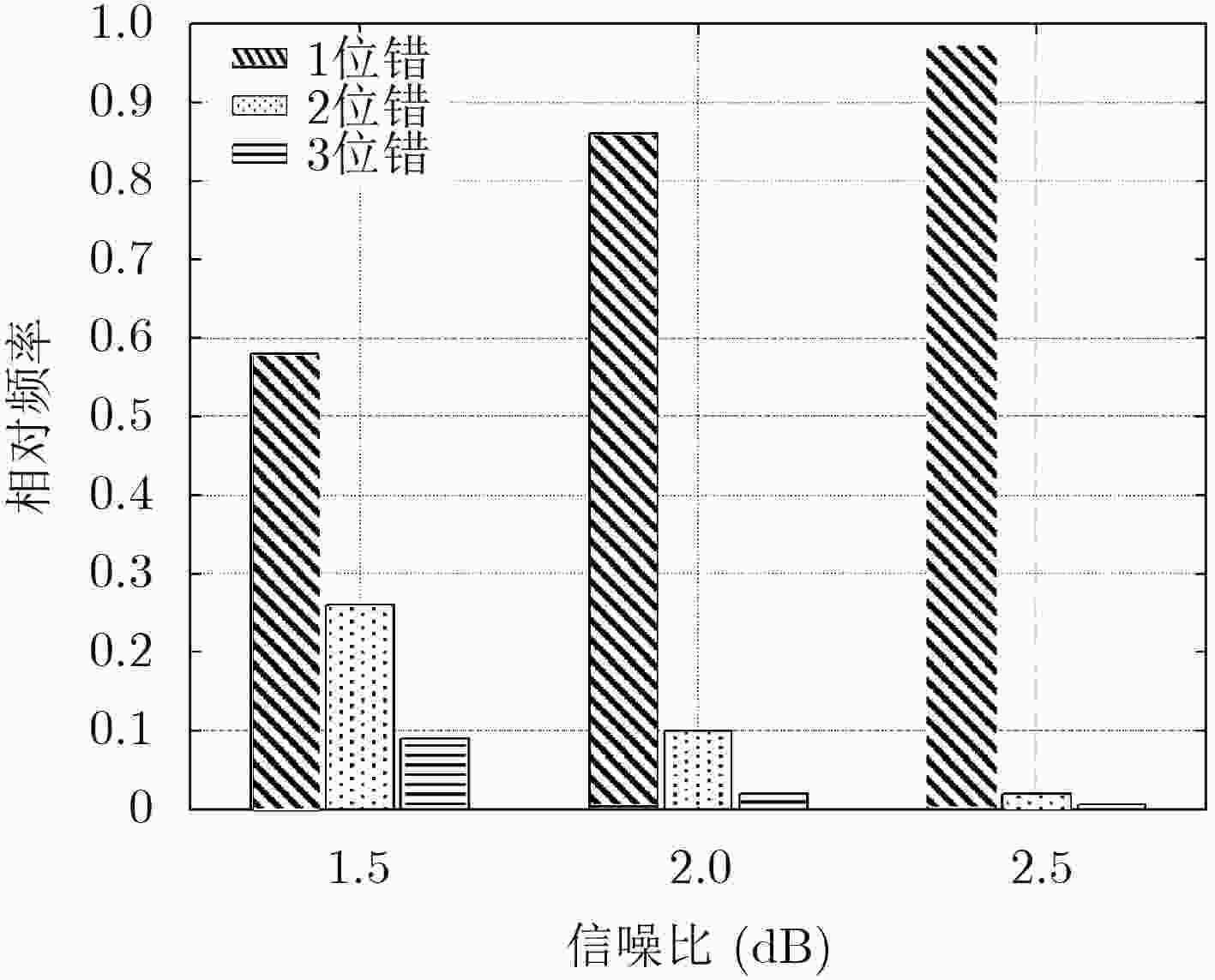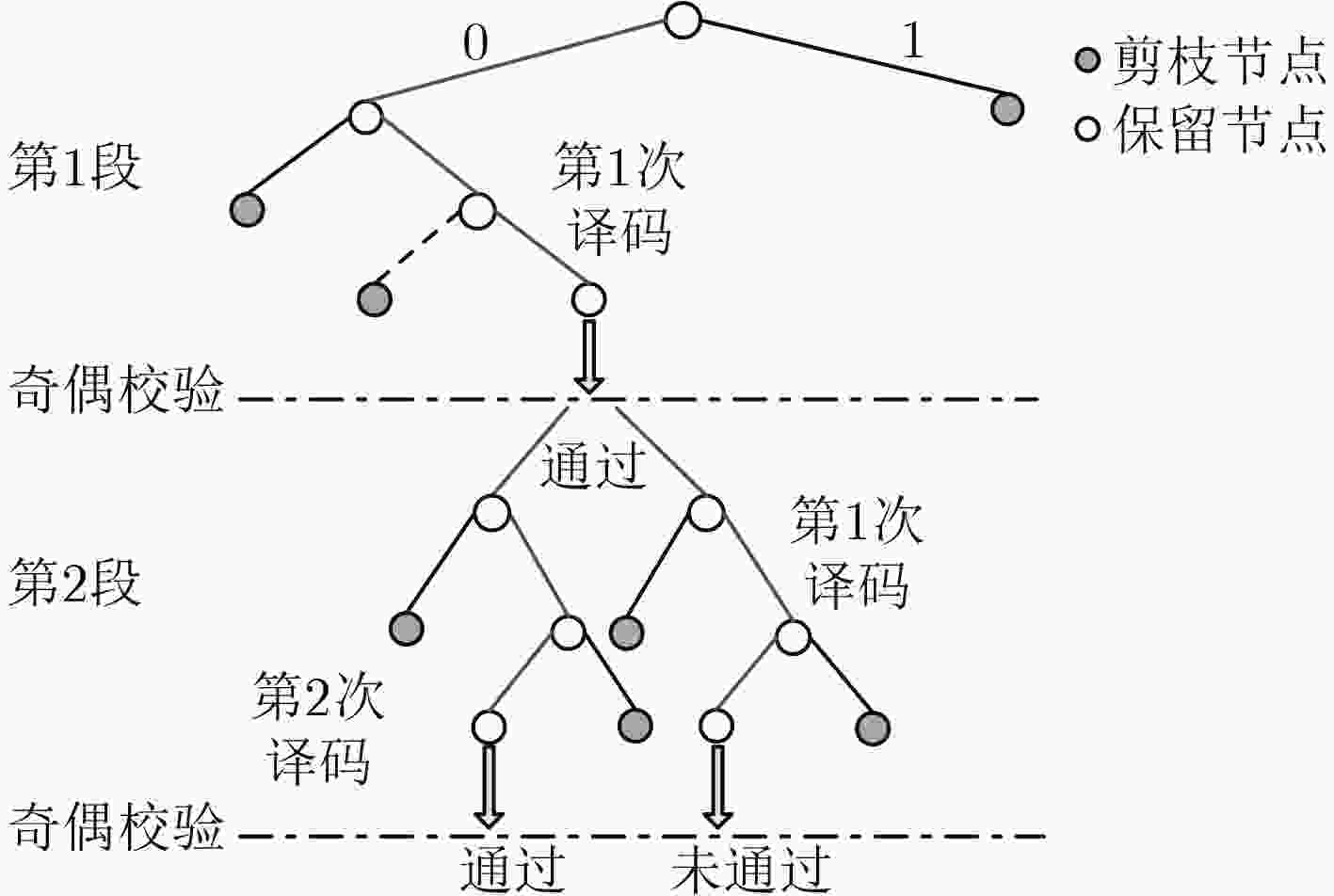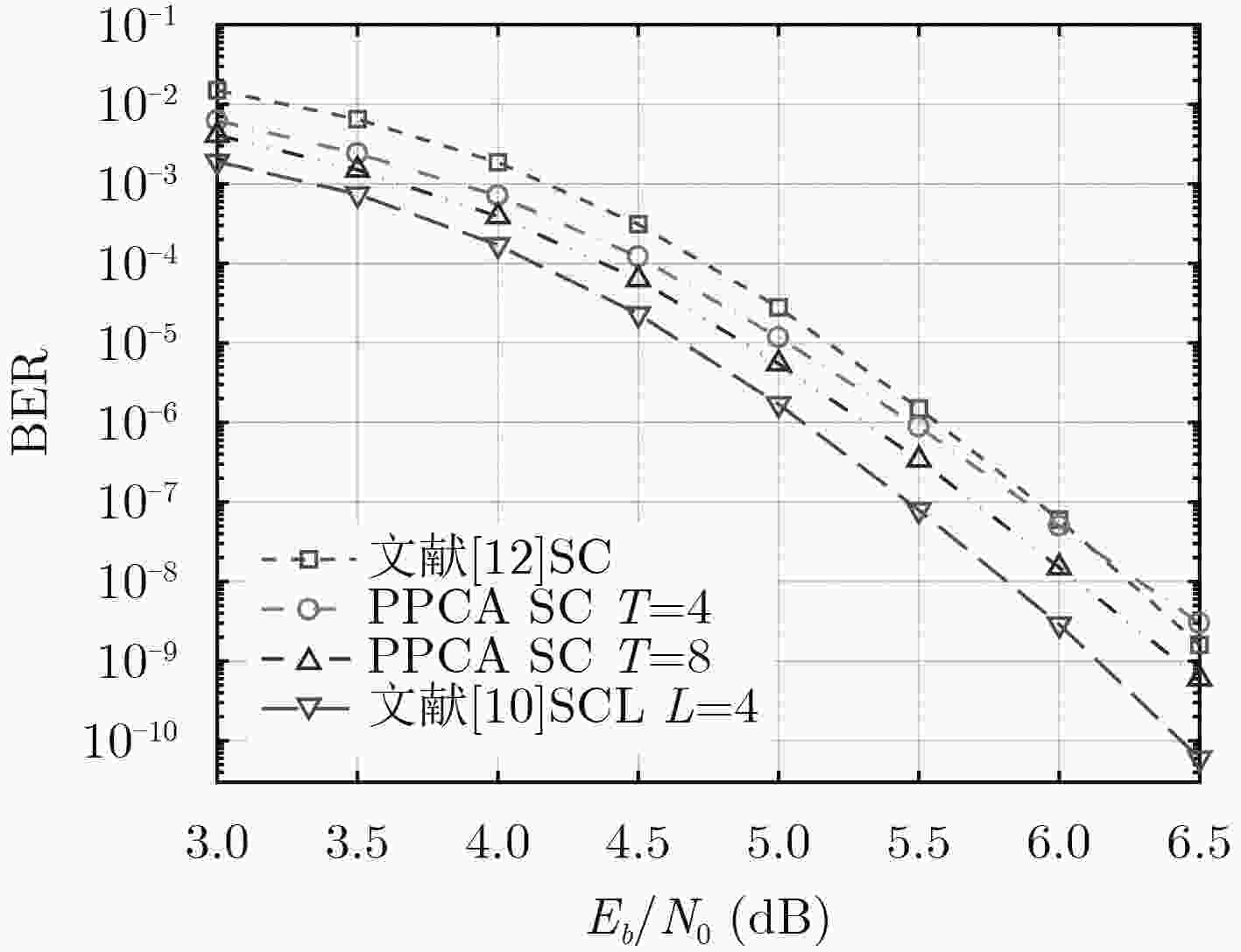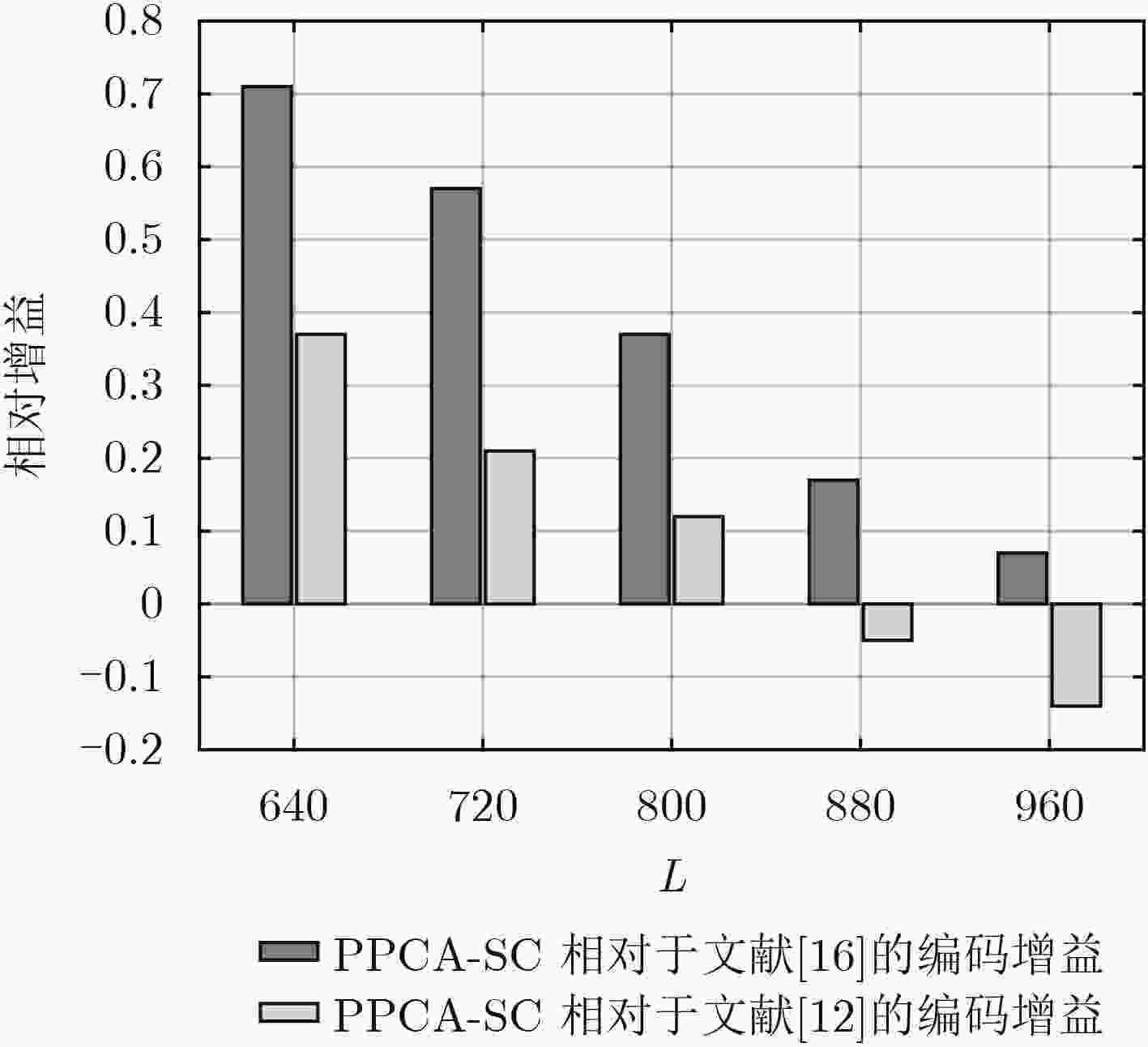Concatenated Polar Codes Scheme Based on Segmented Puncturing
-
摘要: 极化码拥有出色的纠错性能,但编码方式决定了其码长不够灵活,需要通过凿孔构造码长可变的极化码。该文引入矩阵极化率来衡量凿孔对极化码性能的影响,选择矩阵极化率最大的码字作为最佳凿孔模式。对极化码的码字进行分段,有效减小了最佳凿孔模式的搜索运算量。由于各分段的第1个码字都会被凿除,且串行抵消译码过程中主要发生1位错,因此在各段段首级联奇偶校验码作为译码提前终止标志,检测前段码字的译码错误并进行重新译码。对所提方法在串行抵消译码下的性能进行仿真分析,结果表明,相比传统凿孔方法,所提方法在10–3误码率时能获得约0.7 dB的编码增益,有效提升了凿孔极化码的译码性能。Abstract: Polar codes have outstanding error correction performance, but the code length of conventional polar codes is not compatible because of their coding method. To construct rate-compatible polar codes, a segmented puncturing method is proposed. Using the rate of polarization, the puncturing effect is measured and the codeword is removed to make the largest rate of polarization, which is the optimal puncturing mode. As the first codeword of the optimal puncturing mode is 0, the parity check codes are introduced to detect the decoding error of preceding segments codeword. The decoding performance of the method is simulated, results show that this method can obtain about 0.7 dB coding gain at 10–3 bit error rate compared with the traditional puncturing method, which can effectively improve the performance of the punctured polar codes.
-
Key words:
- Polar codes /
- Successive cancellation decoding /
- Puncturing /
- Parity check codes /
- Bit error rate
-
表 1 不同分段码长s 的译码性能增益比较
码长N Eb/N0(dB) 32 64 128 256 512 1024 s=4 0 0 0 0 0 0 s=8 0.012 0.036 0.091 0.108 0.138 0.159 s=16 –0.107 –0.043 0.055 0.118 0.188 0.233 最优s 8 8 8 16 16 16 对应m 4 8 16 16 32 64 表 2 剩余码长分配方法
算法1:剩余码长分配方法 输入:N, L,m, s 输出: ${L_1}$, ${L_2}$, ${n_1}$, ${n_2}$ (1) 定义 ${L_1},\;{L_2}$为各分段中较短与较长的分段剩余码长; (2) 定义 ${n_{\min }},\;{n_{\max }}$为分段剩余码长为 ${L_1},\;{L_2}$的分段个数; (3) 较短分段剩余码长 ${L_1} \!=\!\! \left\lfloor \!{\displaystyle\frac{{sL}}{N}}\! \right\rfloor $,较长分段剩余码长 ${L_2} \! =\! \! \left\lceil \!{\displaystyle\frac{{sL}}{N}}\! \right\rceil $; (4) ${n_1}$与 ${n_2}$的比值为: $\frac{{{n_1}}}{{{n_2}}} = \frac{{m{L_2} - L}}{{L - m{L_1}}}$; (5) ${L_1}$的个数 ${n_1} = \frac{{m{L_2}{\rm{ - }}L}}{{{L_2} - {L_1}}}$, ${L_{\max }}$的个数 ${n_2} = \frac{{L{\rm{ - }}m{L_1}}}{{{L_2} - {L_1}}}$。 表 3 N=8对应的最佳凿孔模式
L ${{E} _{\max }}{\rm{(}}{{G}})$ ${{{P}}_{8,L}}$ 7 0.6008 01111111 6 0.6022 01111110 5 0.5949 00011111 表 4 N=16对应的最佳凿孔模式
L ${{E} _{\max }}{\rm{(}}{{G}})$ ${{{P}}\!_{16,L}}$ 15 0.5445 0111111111111111 14 0.5635 0111111111111110 13 0.5616 0111111111111100 12 0.5654 0111111111111000 11 0.5764 0111111011111000 10 0.5794 0111111011101000 9 0.5582 0111011011101000 表 5 PPCA-SC复杂度比较
信噪比(dB) 时间复杂度 1.5(PPCA-SC) 12275 2.0(PPCA-SC) 10858 2.5(PPCA-SC) 10360 SC 10240 表 6 PPCA-SC平均重复译码次数比较
码长 平均重复译码次数 256 0.72 512 0.47 1024 0.20 表 7 最大重复次数对PPCA-SC复杂度的影响
信噪比(dB) 最大重复次数 时间复杂度 1.5 4 3522 2 2527 2.0 4 2486 2 2331 2.5 4 2126 2 2107 表 8 分段数对PPCA-SC复杂度的影响
信噪比(dB) 分段数 时间复杂度 1.5 16 3522 8 3424 2.0 16 2466 8 2338 2.5 16 2126 8 2121 -
ARIKAN E and TELATAR E. On the rate of channel polarization[C]. 2009 IEEE International Symposium on Information Theory, Seoul, Korea, 2009: 1493–1495. SASOGLU E, TELATAR E, and ARIKAN E. Polarization for arbitrary discrete memoryless channels[C]. IEEE Information Theory Workshop, Taormina, Italy, 2009: 144–148. VANGALA H, HONG Y, and VITERBO E. Efficient algorithms for systematic polar encoding[J]. IEEE Communications Letters, 2016, 20(1): 17-20. DOI: 10.1109/LCOMM.2015.2497220. TAHIR B and RUPP M. New construction and performance analysis of polar codes over AWGN channels[C]. 2017 24th International Conference on Telecommunications (ICT), Limassol, Cyprus, 2017: 1–4. NIU Kai and CHEN Kai. CRC-aided decoding of polar codes[J]. IEEE Communications Letters, 2012, 16(10): 1668-1671. DOI: 10.1109/LCOMM.2012.090312.121501. SHARMA A and SALIM M. Polar code: The channel code contender for 5G scenarios[C]. IEEE International Conference on Computer, Communications and Electronics, Jaipur, India, 2017: 676–682. CHANDESRIS L, SAVIN V, and DECLERCQ D. On puncturing strategies for polar codes[C]. IEEE International Conference on Communications Workshops, Paris, France, 2017: 766–771. BIOGLIO V, GABRY F, and LAND I. Low-complexity puncturing and shortening of polar codes[C]. Wireless Communications and Networking Conference Workshops, San Francisco, USA, 2017: 1–6. ESLAMI A and PISHRO N. A practical approach to polar codes[C]. IEEE International Symposium on Information Theory Proceedings, St. Petersburg, Russia, 2011: 16–20. HONG S N, HUI D, and MARIĆ I. On the catastrophic puncturing patterns for finite-length polar codes[C]. Signals, Systems and Computers, 2016, Asilomar Conference, Pacific Grove, USA, 2017: 235–239. NIU Kai, CHEN Kai, and LIN Jiaru. Beyond turbo codes: Rate-compatible punctured polar codes[C]. IEEE International Conference on Communications, Pacific Grove, USA, 2013: 3423–3427. WANG Runxin and LIU Rongke. A novel puncturing scheme for polar codes[J]. IEEE Communications Letters, 2014, 18(12): 2081–2084. DOI: 10.1109/LCOMM.2014.2364845. KORADA S B, ŞAŞOǦLU E, and URBANKE R. Polar codes: Characterization of exponent, bounds, and constructions[J]. IEEE Transactions on Information Theory, 2010, 56(12): 6253-6264. DOI: 10.1109/TIT.2010.2080990. LEE M K and YANG K. The exponent of a polarizing matrix constructed from the Kronecker product[J]. Designs Codes & Cryptography, 2014, 70(3): 313-322. DOI: 10.1007/s10623-012-9689-z. SHIN D M, LIM S C, and YANG K. Mapping selection and code construction for 2.m-ary polar-coded modulation[J]. IEEE Communications Letters, 2012, 16(6): 905-908. DOI: 10.1109/LCOMM.2012.040912.120070 SHIN D M, LIM S C, and YANG K. Design of Length-compatible polar codes based on the reduction of polarizing matrices[J]. IEEE Transactions on Communications, 2013, 61(7): 2593-2599. DOI: 10.1109/TCOMM.2013.052013.120543. AFISIADIS O, BALATSOUKAS-STIMMING A, and BURG A. A low-complexity improved successive cancellation decoder for polar codes[C]. Signals, Systems and Computers, Asilomar Conference, Pacific Grove, USA, 2014: 2116–2120. -






 下载:
下载:









 下载:
下载:
